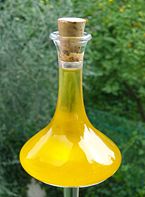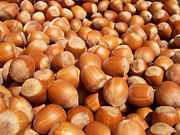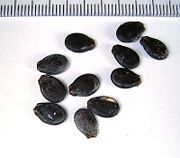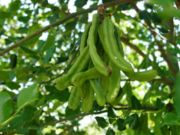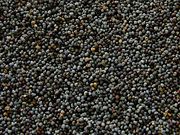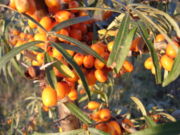List of vegetable oils
2008/9 Schools Wikipedia Selection. Related subjects: Food
| Plant oils | |
|---|---|
| Olive oil | |
| Types | |
| Vegetable fats | (list) |
| Macerated | ( list) |
| Uses | |
| Drying oil - Oil paint | |
| Cooking oil | |
| Fuel - Biodiesel | |
| Components | |
| Saturated fat | |
| Monounsaturated fat | |
| Polyunsaturated fat | |
| Trans fat | |
This list of vegetable oils includes all vegetable oils that are extracted from plants. There are three methods for removing the oil. The relevant part of the plant may be placed under pressure to "extract" the oil, giving an expressed oil. Oils may also be extracted from plants by dissolving parts of plants in water or another solvent. The solution may be separated from the plant material and concentrated, giving an extracted or leached oil. The mixture may also be separated by distilling the oil away from the plant material. Oils extracted by this latter method are called essential oils. Essential oils often have different properties and uses than pressed or leached vegetable oils. Macerated oils are made by infusing parts of plants in a base oil a process known as maceration.
Although most plants contain some oil, only the oil from certain major oil crops complemented by a few dozen minor oil crops is widely used and traded. These oils are one of several types of plant oils.
Vegetable oils can be classified in several ways, for example:
- By source: most, but not all vegetable oils are extracted from the fruits or seeds of plants, and the oils may be classified by grouping oils from similar plants, such as "nut oils".
- By use: oils from plants are used in cooking, for fuel, for cosmetics, for medical purposes, and for other industrial purposes.
The vegetable oils are grouped below in common classes of use.
Edible oils
Major oils

These oils account for a significant fraction of world-wide edible oil production. All are also used as fuel oils.
- Coconut oil, a cooking oil, high in saturated fat, particularly used in baking and cosmetics.
- Corn oil, a common cooking oil with little odour or taste.
- Cottonseed oil, used in manufacturing potato chips and other snack foods. Very low in trans fats.
- Olive oil, used in cooking, cosmetics, soaps, and as a fuel for traditional oil lamps.
- Palm oil, the most widely produced tropical oil. Also used to make biofuel.
- Peanut oil (Ground nut oil), a clear oil used for dressing salads and, due to its high smoke point, especially used for frying.
- Rapeseed oil, including Canola oil, one of the most widely used cooking oils.
- Safflower oil, produced for export for over 50 years, first for use in paint industry, now mostly as a cooking oil.
- Sesame oil, cold pressed as light cooking oil, hot pressed for a darker and stronger flavor.
- Soybean oil, produced as a byproduct of processing soy meal.
- Sunflower oil, a common cooking oil, also used to make biodiesel.
Nut oils
Nut oils are generally used in cooking, for their flavor. They are also quite costly, because of the difficulty of extracting the oil.
- Almond oil, used as an edible oil, but primarily in the manufacture of pharmaceuticals.
- Cashew oil, somewhat comparable to olive oil. May have value for fighting dental cavities.
- Hazelnut oil, mainly used for its flavor. Also used in skin care, because of its slight astringent nature.
- Macadamia oil, strongly flavored, contains no trans-fats, and a good balance of omega-3 and omega-6.
- Mongongo nut oil (or manketti oil), from the seeds of the Schinziophyton rautanenii, a tree which grows in South Africa. High in vitamin E. Also used in skin care.
- Pecan oil, valued as a food oil, but requiring fresh pecans for good quality oil.
- Pine nut oil usually added to foods as a flavoring agent.
- Pistachio oil, strongly flavored oil, particularly for use in salads.
- Walnut oil, used for its flavor, also used by Renaissance painters in oil paints.
Oils from melon and gourd seeds
Members of the cucurbitaceae include gourds, melons, pumpkins, and squashes. Seeds from these plants are noted for their oil content, but little information is available on methods of extracting the oil. In most cases, the plants are grown as food, with dietary use of the oils as a byproduct of using the seeds as food.
- Bottle gourd oil, extracted from the seeds of the Lagenaria siceraria, widely grown in tropical regions throughout the world. Used medicinally and as an edible oil.
- Buffalo gourd oil, from the seeds of the Cucurbita foetidissima, a vine with a rank odour, native to southwest North America.
- Pumpkin seed oil, a specialty cooking oil, produced in Austria and Slovenia. Poor tolerance for high temperatures.
- Watermelon seed oil, pressed from the seeds of Citrullus vulgaris. Traditionally used in cooking in West Africa.
Food supplements
A number of oils are used as food supplements, for their nutrient content or medical effect.
- Acai oil, from the fruit of several species of the Açaí Palm (Euterpe). Grown in the Amazon region. Similar to grape seed oil. They are used in cosmetics and as a food supplement.
- Blackcurrant seed oil, used as a food supplement, because of high content of omega-3 and omega-6 fatty acids.
- Borage seed oil, similar to blackcurrant seed oil, used primarily medicinally.
- Evening primrose oil, used as a food supplement for its purported medicinal properties.
Other edible oils
- Amaranth oil, high in squalene and unsaturated fatty acids, used in food and cosmetic industries.
- Apricot oil, similar to, but much cheaper than almond oil, which it resembles. Only obtained from certain cultivars.
- Apple seed oil, used in cosmetics and shampoos. Also used as an edible oil.
- Argan oil, a food oil from Morocco that has also attracted recent attention in Europe.
- Artichoke oil, extracted from the seeds of the Cynara cardunculus. Similar in use and composition to safflower and sunflower oil.
- Avocado oil, used a substitute for olive oil. Also used in cosmetics. Unusually high smoke point of 510°F.
- Babassu oil, similar to, and used as a substitute for, coconut oil.
- Ben oil, extracted from the seeds of the Moringa oleifera. High in behenic acid. Extremely stable edible oil. Also suitable for biofuel.
- Borneo tallow nut oil, extracted from the fruit of species of genus Shorea. Used as a substitute for cocoa butter, and to make soap, candles, cosmetics and medicines.
- Cape Chestnut oil, otherwise known as Yangu oil, is a popular oil in African skin care.
- Cocoa butter, from the cacao plant. Used in the manufacture of chocolate, as well as in some cosmetics.
- Carob pod oil (Algaroba oil), from carob, used medicinally.
- Cocklebur oil, from species of genus Xanthium, with similar properties to poppyseed oil, similar in taste and smell to sunflower oil.
- Cohune oil, from the Attalea cohune (cohune palm), similar to coconut oil in makeup and usage
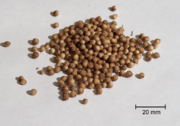
- Coriander seed oil, from coriander seeds, used medicinally. Also used as a flavoring agent in pharmaceutical and food industries.
- Dika oil, from Irvingia gabonensis seeds, native to West Africa. Used to make margarine, soap and pharmaceuticals, where is it being examined as a tablet lubricant. Largely underdeveloped.
- False flax oil made of the seeds of Camelina sativa, available in Russia as ryjhikovoye maslo (рыжиковое масло). Considered promising as a food or fuel oil.
- Flax seed oil (called linseed oil when used as a drying oil). High in omega 3 and lignans, which can be used medicinally. Easily turns rancid.
- Grape seed oil, suitable for cooking at high temperatures. Also used as a salad oil, and in cosmetics.
- Hemp oil, a high quality food oil.
- Kapok seed oil, used as an edible oil, and in soap production.
- Lallemantia oil, from the seeds of Lallemantia iberica, discovered at archeological sites in northern Greece.
- Marula oil, extracted from the kernel of Sclerocarya birrea. Used in the food and cosmetic industry, it has strong antioxidant and moisturising properties.
- Meadowfoam seed oil, highly stable oil, with over 98% long-chain fatty acids. Competes with rapeseed oil for industrial applications.
- Mustard oil (pressed), used in India as a cooking oil. Also used as a massage oil.
- Nutmeg butter, extracted by expression from the fruit of cogeners of genus Myristica. Nutmeg butter has a large amount of trimyristin. Nutmeg oil, by contrast, is an essential oil, extracted by steam distillation.
- Okra seed oil ( Hibiscus seed oil), from the seed of the Hibiscus esculentus. Composed predominantly of oleic and linoleic acids. The greenish yellow edible oil has a pleasant taste and odour.
- Papaya seed oil.
- Perilla seed oil, high in omega-3 fatty acids. Used as an edible oil, for medicinal purposes, in skin care products and as a drying oil.
- Pequi oil, extracted from the seeds of Caryocar brasiliensis. Used in Brazil as a highly prized cooking oil.
- Pine nut oil. An expensive food oil, from pine nuts, used in salads and as a condiment.
- Poppyseed oil, used for cooking, moisturizing skin, in paints and varnishes, and in soaps.
- Prune kernel oil, marketed as a gourmet cooking oil.
- Quinoa oil, similar in composition and use to corn oil.
- Ramtil oil, pressed from the seeds of the one of several species of genus Guizotia abyssinica (Niger pea) in India and Ethiopia. Used for both cooking and lighting.
- Rice bran oil, suitable for high temperature cooking. Widely used in Asia.
- Royle oil, pressed from the seeds of Prinsepia utilis, a wild, edible oil shrub that grows in the higher Himalayas. Used medicinally in Nepal.
- Sacha Inchi oil, from the Peruvian Amazon. High in omega-3 and omega-6 fatty acids.
- Tea oil (Camellia oil), widely used in southern China as a cooking oil. Also used in making soaps, hair oils and a variety of other products.
- Thistle oil, pressed from the seeds of Silybum marianum. Relatively unstable. Also used for skin care products.
- Tomato seed oil. High in unsaturated fats and lysine. Potentially useful as a protein supplement.
- Wheat germ oil, used as a food supplement, and for its "grainy" flavor. Also used medicinally. Highly unstable.
Oils used for biofuel
A number of the oils listed above are used for biofuel (biodiesel and Straight Vegetable Oil) in addition to having other uses. A number of oils are used only as biofuel.
Although diesel engines were invented, in part, with vegetable oil in mind, diesel fuel is almost exclusively petroleum-based. Rising oil prices have made biodiesel more attractive. Vegetable oils are evaluated for use as a biofuel based on:
- Suitability as a fuel, based on flash point, energy content, viscosity, combustion products and other factors
- Cost, based in part on yield, effort required to grow and harvest, and post-harvest processing cost
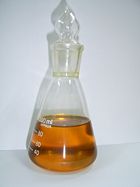
Inedible oils used only or primarily as biofuel
These oils are extracted from plants that are cultivated solely for producing oil-based biofuel. These, plus the major oils described above, have received much more attention as fuel oils than other plant oils.
- Algae oil, recently developed by MIT scientist Isaac Berzin. Byproduct of a smokestack emission reduction system.
- Copaiba, an oleoresin tapped from species of genus Copaifera. Used in Brazil as a cosmetic product and a major source of biodiesel.
- Honge oil, pioneered as a biofuel by Udipi Shrinivasa in Bangalore, India.
- Jatropha oil, widely used in India as a fuel oil. Has attracted strong proponents for use as a biofuel.
- Jojoba oil, from the Simmondsia chinensis, a desert shrub.
- Milk bush, popularized by chemist Melvin Calvin in the 1950s. Researched in the 1980s by Petrobras, the Brazilian national petroleum company.
- Petroleum nut oil, from the Petroleum nut ( Pittosporum resiniferum ) native to the Philippines. The Philippine government once explored the use of the petroleum nut as a biofuel.
Drying oils
Drying oils are vegetable oils that dry to a hard finish at normal room temperature. Such oils are used as the basis of oil paints, and in other paint and wood finishing applications. In addition to the oils listed here, walnut, sunflower and safflower oil are also considered to be drying oils.
- Dammar oil, from the Canarium strictum, used in paint as a drying agent. Can also be used as in oil lamps.
- Linseed oil, used in paints, also suitable for human consumption.
- Poppyseed oil, similar in usage to linseed oil but with better colour stability.
- Stillingia oil (also called Chinese vegetable tallow oil), obtained by solvent from the seeds of Sapium sebiferum. Used as a drying agent in paints and varnishes.
- Tung oil, used in wood finishing.
- Vernonia oil is produced from the seeds of the Vernonia galamensis. It is composed of 73-80% vernolic acid, which can be used to make epoxies for manufacturing adhesives, varnishes and paints, and industrial coatings.
Other oils
A number of pressed vegetable oils are either not edible, or not used as an edible oil.
- Amur cork tree fruit oil, pressed from the fruit of the Phellodendron amurense, used medicinally and as an insecticide.
- Balanos oil, pressed from the seeds of Balanites aegyptiaca, was used in ancient Egypt as the base for perfumes.
- Bladderpod oil, pressed from the seeds of Lesquerella fendleri, native to North America. Rich in lesquerolic acid, which is chemically similar to the ricinoleic acid found in castor oil. Many industrial uses. Possible substitute for castor oil as it requires much less moisture than castor beans.
- Brucea javanica oil, extracted from the seeds of the Brucea javanica. Used medicinally.
- Burdock oil (Bur oil) extracted from the root of the burdock. Used medicinally in scalp treatment.
- Candlenut oil ( Kukui nut oil), produced in Hawai'i, used primarily for skin care products.
- Carrot seed oil (pressed), from carrot seeds, used in skin care products.
- Castor oil, with many industrial and medicinal uses. Castor beans are also a source of the toxin ricin.
- Chaulmoogra oil, from the seeds of Taraktogenos kurzii, used for many centuries, internally and externally, to treat leprosy. Also used to treat secondary syphilis, rheumatism, scrofula, and in phthisis.
- Crambe oil, extracted from the seeds of the Crambe abyssinica, is used as an industrial lubricant, a corrosion inhibitor, and as an ingredient in the manufacture of synthetic rubber.
- Cuphea oil, from a number of species of genre Cuphea. Of interest as sources of medium chain triglycerides.
- Jojoba oil, used in cosmetics as an alternative to whale oil spermaceti.
- Lemon oil, similar in fragrance to the fruit. One of a small number of cold pressed essential oils. Used medicinally, as an antiseptic, and in cosmetics.
- Mango oil, pressed from the stones of the mango fruit, is high in stearic acid, and can be used for making soap.
- Mowrah butter, from the seeds of the Madhuca latifolia and Madhuca longifolia, both native to India. Crude Mowrah butter is used as a fat for spinning wool, for making candles and soap. The refined fat is used as an edible fat and vegetable ghee in India.
- Neem oil, used in cosmetics, for medicinal purposes, and as an insecticide.
- Ojon oil, extracted from the nut of the American palm ( Elaeis oleifera). Used as a skin and hair treatment. Oil extracted from both the nut and husk is also used as an edible oil in Central and South America.
- Orange oil, like lemon oil, cold pressed rather than distilled. Consists of 90% d- Limonene. Used as a fragrance, in cleaning products and in flavoring foods.
- Palm oil, extracted from the kernel of the palm fruit. High in saturated fats. Popular in West African and Brazilian cuisine.
- Rosehip seed oil, used primarily in skin care products, particularly for aging or damaged skin. Produced in Chile.
- Sea buckthorn oil, derived from Hippophae rhamnoides, produced in northern China, used primarily medicinally.
- Shea butter, used primarily in skin care products.
- Snowball seed oil ( Viburnum oil), from Viburnum opulus seeds. High in tocopherol, carotinoides and unsaturated fatty acids. Used medicinally.
- Tall oil, produced as a byproduct of wood pulp manufacture. A further byproduct called tall oil fatty acid (TOFA) is a cheap source of oleic acid.
- Tamanu oil, originates in Tahiti, from the Calophyllum tacamahaca, used for skin care and medicinally.
- Tonka bean oil (Cumaru oil), used for flavoring tobacco and snuff.
